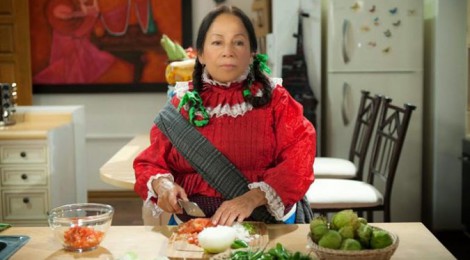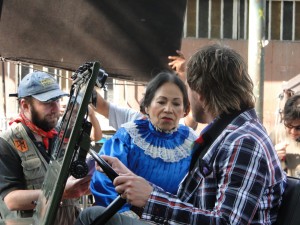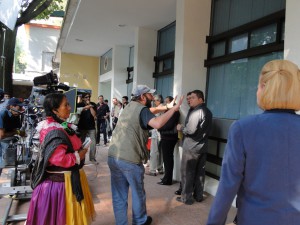
María Elena Velasco, December 17, 1940–May 1, 2015
This week, Mediático presents an obituary to María Elena Velasco, one of the Mexican film industry’s leading figures, written by Seraina Rohrer director of the Solothurn Film Festival in Switzerland whose PhD focused on the legendary actress, director and creator of the iconic ‘La India María’. Seraina has been a Visiting Scholar at the Chicano Studies Research Center of the University of California Los Angeles (July 2009 to August 2010). She has also headed the Press Office of the Locarno International Film Festival (2003–2008). She writes a column in the newspaper NZZ am Sonntag and has taught film at the University of Zurich and ECAL. She has previously published on María Elena Velasco in The Journal of Latino/Latin American Studies and is currently preparing a manuscript about formula filmmaking in Mexico.
https://www.youtube.com/watch?feature=player_embedded&v=jw-WwFPQ2_E
On May 1, Mexico’s film industry lost one of its leading figures: María Elena Velasco, best known as La India María. For five decades, Velasco played a humble and stubborn indigenous Mexican woman — a performance notable for its marked ethnicity and slapstick humor. Her iconic character remains controversial. Some critics view La India María as a racist depiction of a negative stereotype, while others see the widely beloved character as a sly, transgressive critique against discrimination and those in power.
Born and raised in Puebla, Velasco created the character La India María shortly after she launched her acting career in Mexico City’s vaudeville theaters. In an interview she told me that the character La India María was inspired by indigenous Mazahua women from rural Mexico commonly called Las Marías, who began to migrate to Mexico City in the 1960s to sell fruit, candy, and trinkets on the streets of the capital. The character was a runaway hit with stage audiences, and Velasco frequently reprised María for theater fans throughout her career. In 1971, La India María made her first television appearance on the variety show Siempre en Domingo. She won the hearts of TV audiences with her comic performance and naive admiration for the host of the show.
The next year, Velasco played the leading role in the first India María feature film, Tonta tonta, pero no tanto / Stupid Stupid, but not That Much (1972). Fifteen other films followed, including Ni de aquí, ni de allá / Neither From Here, Nor From There (MX, 1988) and her most recent comedy La Hija De Moctezuma / The Daughter of Moctezuma (2014). By the mid-1970s, her films were among the top box office grossers in Mexico, across Latin America, and in Latino neighborhoods in the United States.
Most India María comedies follow a similar formula: La India María is exploited, but in the end, she defeats her adversaries and unmasks their corruption. For many Mexican and U.S. Latino families, seeing Velasco’s films, singing along with the popular tunes, and applauding when La India María mocked the rich and powerful became a familiar and satisfying weekend ritual. In contrast, film critics have largely dismissed Velasco’s movies as lowbrow entertainment for the masses that reinforces negative stereotypes. The administration of President Vicente Fox even made an unsuccessful attempt to ban all India María films because of their depiction of indigenous ethnicity.
In addition to her work as an actress, María Elena Velasco directed five her own films in order to exercise more control over the character. In the late 1985 she founded her own production company, together with her children Iván and Ivette Goretti Lipkies. Velasco collaborated with other big-name comedians and recruited experienced film industry workers to bring to the screen audience-pleasing productions that guaranteed Velasco the artistic freedom she wanted.
Velasco on set during filming of La hija de Moctezuma (photograph by author, 2011)
Velasco’s accomplishments as a director and producer have been widely overlooked—or deliberately ignored. During the 1970s and 1980s, only a handful of women worked behind the camera: Marcela Fernández Violante, Busi Cortés, María Novaro, and Isela Vega. With the exception of Vega, all went to film school and made auteur films that targeted international festival and art house audiences. Isela Vega, like María Elena Velasco, worked in commercial filmmaking. They learned on the job, as did many other industry professionals working in commercial film production. On the set of her films, Velasco worked with enthusiasm, constantly motivating her crew to create great family entertainment, making the most of the at times low budgets.
Filming a scene from La hija de Moctezuma (photograph by author, 2011)
For what she lacked in critical acclaim, Velasco became one of Mexico’s most prolific female director-producer and created a spirited and unforgettable character that Mexican audiences loved for half a century — and will sorely miss. As for the critics, it is time they reconsider Velasco work and her character.








